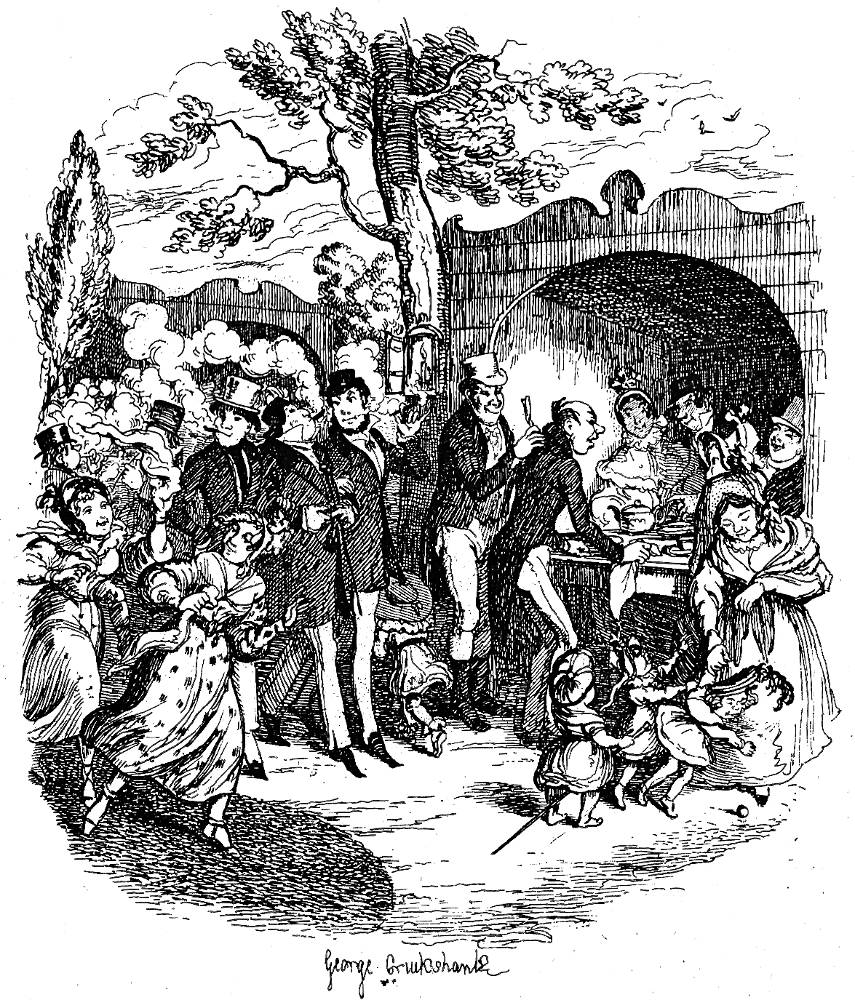The Tea Garden as a Social Institution
Over 200 outdoor pleasure gardens and tea gardens proliferated in London from the 16th to the early 19th centuries. Primarily frequented by working class people who lived in the city, they were located in the pleasanter parts of London's suburbs. In days of yore, the countryside was only a walk (or short carriage drive or ferry ride) away from the city center. Tea and pleasure gardens afforded the populace a respite from the sights, smells, and congestion of city life. — "18th & 19th Century Pleasure and Tea Gardens in London." Jane Austen's World.

Jack Straw’s Castle in 1965.
The character of these places have, with the habits of the people, experienced a very considerable change, and tea, formerly the chief article of consumption here, has been supplanted by liquors of a more stimulating character. At some of these, concerts, of an inferior description, are performed; and other attractions are added that generally detain the company, always of a miscellaneous character, till the approach of midnight. The following are the principal in the vicinity of the metropolis: — New Bagnigge Wells, Bayswater; New Bayswater Tea Gardens; Bull and Bush, Hampstead; Camberwell Grove House; Canonbury House, Islington; Chalk Farm, Primrose Hill; Copenhagen House, Holloway Fields; Eel-pie House, or Sluice House, on the New River, near Hornsey: St. Helena Gardens, near the Lower Road, Deptford ; Highbury Barn ; Hornsey Wood House, the grounds of which include a fine wood and an extensive piece of water; Jack Straw's Castle, Hampstead Heath; Kilburn Wells, Edgeware Road; Mermaid, Hackney; Montpelier, Walworth; Mount Pleasant, Clapton; the Eagle, City Road; the Red House, Battersea Fields; Southampton Arms, Camden Town; Union Gardens, Chelsea; White Conduit House, Islington; and Yorkshire Stingo, Lisson Green. — Mogg's New Picture of London and Visitor's Guide to it Sights, 1844; cited in Jackson.

The Bull and Bush in 1965. The partying continues on a lovely sunny afternoon.
Charles Dickens’s Sketches by Boz on London Tea-Gardens
Let us turn now, to another portion of the London population, whose recreations present about as strong a contrast as can well be conceived — we mean the Sunday pleasurers; and let us beg our readers to imagine themselves stationed by our side in some well-known rural "Tea-gardens."
The heat is intense this afternoon, and the people, of whom there are additional parties arriving every moment, look as warm as the tables which have been recently painted, and have the appearance of being red-hot. What a dust and noise! Men and women — boys and girls — sweethearts and married people — babies in arms, and children in chaises — pipes and shrimps— cigars and periwinkles — tea and tobacco. Gentlemen, in alarmingwaistcoats, and steel watch-guards, promenading about, three abreast, with surprisingdignity (or as the gentleman in the next box facetiously observes, "cutting it uncommon fat!") — ladies, with great, long, white pocket-handkerchiefs like smalltable-cloths, in their hands, chasing one another on the grass in the most playful andinteresting manner, with the view of attracting the attention of the aforesaid gentlemen— husbands in perspective ordering bottles of ginger-beer for the objects of theiraffections, with a lavish disregard of expense; and the said objects washing down huge quantities of "shrimps" and "winkles," with an equal disregard of their own bodily health and subsequent comfort — boys, with great silk hats just balanced on the top oftheir heads, smoking cigars, and trying to look as if they liked them — gentlemen in pink shirts and blue waistcoats, occasionally upsetting either themselves, or somebodyelse, with their own canes.

London Recreations. George Cruikshank. 1839. Click on image to enlarge it.
Some of the finery of these people provokes a smile, but they are all clean, and happy, and disposed to be good-natured and sociable. Those two motherly-lookingwomen in the smart pelisses, who are chatting so confidentially, inserting a "ma'am" atevery fourth word, scraped an acquaintance about a quarter of an hour ago: it originatedin admiration of the little boy who belongs to one of them — that diminutive specimen of mortality in the three-cornered pink satin hat with black feathers. The twomen in the blue coats and drab trousers, who are walking up and down, smoking theirpipes, are their husbands. The party in the opposite box are a pretty fair specimen of thegenerality of the visitors. These are the father and mother, and old grandmother: a youngman and woman, and an individual addressed by the euphonious title of "Uncle Bill," whois evidently the wit of the party. They have some half-dozen children with them, but it isscarcely necessary to notice the fact, for that is a matter of course here. Every woman in"the gardens," who has been married for any length of time, must have had twins on two or three occasions; it is impossible to account for the extent of juvenile population in any other way.
Observe the inexpressible delight of the old grandmother, at Uncle Bill's splendid joke of "tea for four: bread-and-butter for forty;" and the loud explosion of mirthwhich follows his wafering a paper "pigtail" on the waiter's collar. The young man is evidently "keeping company" with Uncle Bill's niece: and Uncle Bill's hints — such as "Don't forget me at the dinner, you know," "I shall look out for the cake, Sally," "I'll be godfather to your first — wager it's a boy," and so forth, are equally embarrassingto the young people, and delightful to the elder ones. As to the old grandmother, she is in perfect ecstasies, and does nothing but laugh herself into fits of coughing, until they have finished the "gin-and-water warm with," of which Uncle Bill ordered "glasses round" after tea, "just to keep the night air out, and to do it up comfortable and riglar arter sitch anas-tonishing hot day!" — "Scenes," Chapter 9, "London Recreations," p. 69-71.
Commentary

ickens may have based his sketch, which origially appeared in the Evening Chronicle on 17 March 1835, on the tea-gardens at one of his favourite haunts, Jack Straw's Castle in Hampstead, a pub that still exists today. Throughout the nineteenth century, such tea-gardens provided one of the few means of entertainment available to most Londoners on Sunday afternoons as a consequence of the restrictive Lord's Day Act. Those visiting tea-gardens strolled around ponds and garden statues, and, of course, drank tea. Although Cruikshank's illustration depicts a food-and-beverage bar, it does not include the kind of ornamental fish-pond evident in Harry Furniss's illustration for this particular essay, The City Man's Garden. The tea-gardens, such as Dickens describes, functioned as as the Vauxhall or Ranelagh Gardens for the rising middle-classes. From 1840, shortly after Dickens wrote this sketch, music and dancing were licensed at several inns with tea gardens, such as The Bell in Kilburn High Road.
Dickens sketch describes three very different garden scenes: the wealthy middle-class enjoyer of his own private gardens, directing his gardeners; the retired middle-class couple working amiably together in their garden; and finally men, women, and children on a Sunday afternoon in a London tea-garden. Cruikshank focuses on the latter, addressing not so much the descriptions of "family entertainment" as those of the male celebrants. For example, he places the "Gentlemen, in alarming waistcoats, and steel watch-guards, promenading about, three abreast, with surprising dignity" (70) just to the left of centre, emphasizing by their movements the nine males in the composition, and minimizing the significance of the women by including just five, one a mere head in a bonnet, and including just four children of indeterminate gender.
Bibliography
"18th & 19th Century Pleasure and Tea Gardens in London." Jane Austen's World. Posted March 1, 2009 by Vic. Accessed 27 April 2017. in Jane Austen's World. https://janeaustensworld.wordpress.com/2009/03/01/18th-amp-19th-century-pleasure-and-tea-gardens-in-london/ .
Dickens, Charles. "London Recreations," Chapter 9 in "Scenes," Sketches by Boz. Illustrated by George Cruikshank. London: Chapman and Hall, 1839; rpt., 1890. Pp. 67-71.
Dickens, Charles. "London Recreations," Chapter 9 in "Scenes," Sketches by Boz. Illustrated by Fred Barnard. The Household Edition. London: Chapman and Hall, 1876. Pp. 43-45.
Dickens, Charles. "London Recreations," Chapter 9 in "Scenes," Sketches by Boz. Illustrated by Harry Furniss. The Charles Dickens Library Edition. London: Educational Book Company, 1910. Vol. 1. Pp. 86-91.
Dickens, Charles, and Fred Barnard. The Dickens Souvenir Book. London: Chapman & Hall, 1912.
Jackson, Lee. "Victorian London - Entertainment and Recreation - Gardens - Tea Gardens."Dirty Old London. New Haven: Yale UP, 2014. Accessed 27 April 2017. http://www.victorianlondon.org/entertainment/teagardens.htm
Last modified 11 May 2017